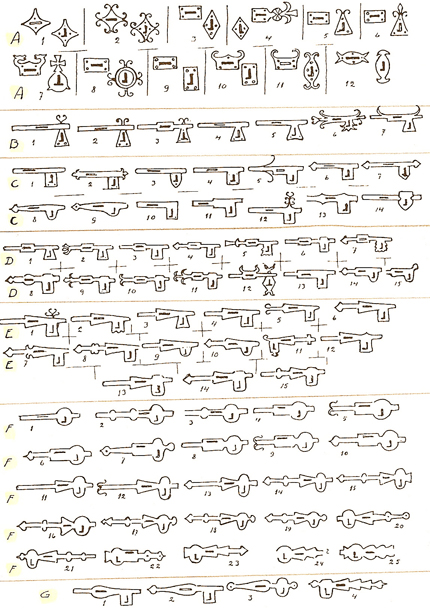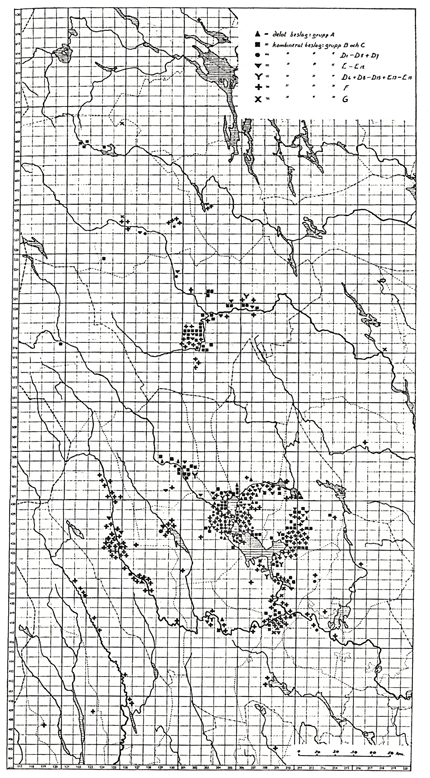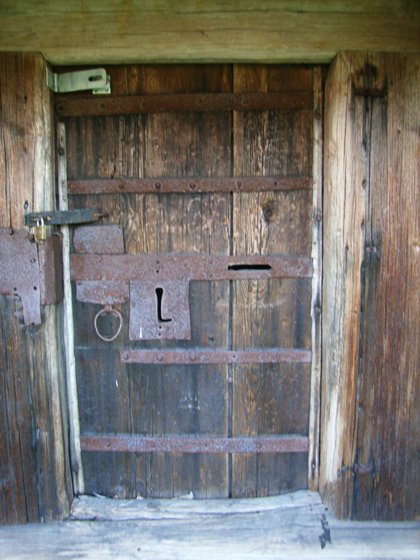Old-fashioned smith-work in Dalarna and its origins
In collaboration with Carl Sahlin, ethnologist and professor Sigurd Erixon began a series of studies in 1942 on the mining industry and simple smithing done by farmers in Sweden. He focused on older technology, cultural environments and living spaces that developed out of the needs of iron production and refining. The smithed products could be dated and generally demonstrated traditional artistic representation. Erixon found that lock and door fittings represent unbroken traditions through the centuries, and that the pull locks of Dalarna were the most unique.
Erixon stated that pull locks were a primitive, yet interesting phase of lock development. The locks, he points out, are a part of the rural culture of wooden buildings, which has been extensively studied and documented in the past decades. At the same time, it is clear that the parish of Lima was long a manufacturing center for pull locks, according to Olle Homman’s report on his study of Lima. Erixon also states that pull locks were extensively exported to Norway by “Western Dalecarlian” peddlers.
Sigurd Erixon first divided pull locks into two main groups, divided, group A and combined, B–G, fittings. In addition, he defined subgroups A–G. It turned out that group A, divided, was smaller than combined.
 |
| Types and variations in shape of pull-lock fittings according to Sigurd Erixon, 1942. |
 |
| Prevalence of pull locks according to Sigurd Erixon, 1942. |
Erixon documented over four hundred fittings – most of them labeled with the parish and farm where they were located. Only a handful are found in museum collections. He also documented the prevalence of most of these pull locks on a map.
Group A is all the divided fittings, where the pull-ring backplate is separate from the key plate. The rhomboid shape has Roman roots. A1 and A2, A5 and A6, and A8 and A9 (7 in all) can also be considered to have medieval shapes.
Group B includes combined fittings with a strip for the pull-ring backplate and a key plate that is reminiscent of the triangular ones in A5-A6. Subgroups B4 and B6 (5 in all) have medieval shapes, with B3 and B4 (4 in all) dating from the 16th century, and B4, B5 and B7 (6 in all) dating from the 17th.
Group C is also characterized by the strip-type pull-ring backplate. Subgroups C1, C4 and C11 (9 in all) are medieval, subgroups C1, C2, and C4 (4 in all) are from the 16th century, subgroups C3, C4, C8 and C10 (8 in all) are from the 17th century, and subgroups C3–C6 and C8–C14 (7 in all) are from the 18th century.
Group D differs from B and C in that the pull-ring strip has a more or less rectangular extension around the ring. Subgroups D1, D3 and D13 (3 in all) are from the 16th century, subgroups D1, D2 and D13 (15 in all) are from the 17th century, and subgroups D7, D14 and D15 (3 in all) are from the 18th century.
Group E, with its truncated lightning-bolt shaped backplate, is much more clearly interrelated than the previous group. Subgroups E2 and E3 (13 in all) are medieval, E3, E4 and E9 (8 in all) are 16th century, and E3, E4, E6, E7 and E13 (13 in all) are 17th century.
Group F has a rounded key plate, which is probably also medieval in nature, even if the shape has been modified since then. The oldest shapes in this group have been dated to the late 16th century. The majority are from the 17th century with some representation from the 18th.
Group G, of which there are just a few, all have a clear 18th-century style and are widely distributed in Hälsingland and Härjedalen.
Sigurd Erixon’s article concludes with a listing of all 433 pull locks covered in the study, including the type, province and parish, quantity, date, and the likely age of the building and the lock.
 |
| A somewhat less elegant pull lock on a building in Hembyn in Anders Zorn’s collection of buildings in Mora, Dalarna. Photo by the author. |